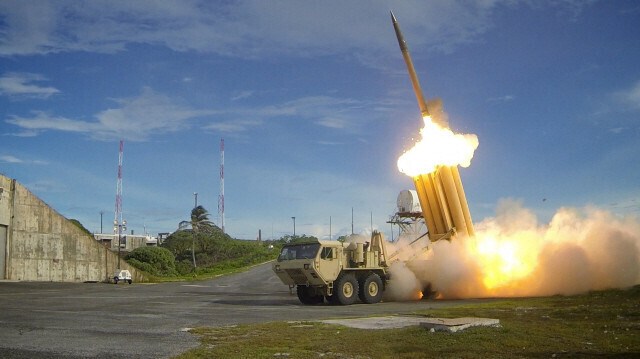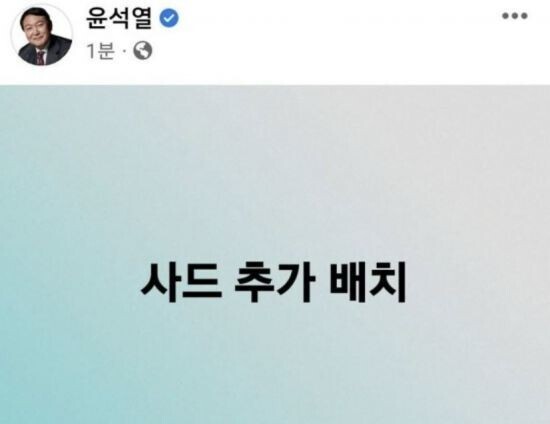hankyoreh
Links to other country sites 다른 나라 사이트 링크
Yoon’s call for additional THAAD to protect Seoul stirs controversy over practicality

Concerning North Korea’s continued missile tests, People Power Party (PPP) presidential candidate Yoon Suk-yeol said on Tuesday that, if elected, he would “establish a multi-level missile defense system that includes Terminal High Altitude Area Defense (THAAD)” in order to “ensure the safety of the Korean people against the threat of nuclear missiles from North Korea, from the greater Seoul area to northern Gyeonggi.”
In a press conference Monday, a subsidiary of Yoon’s election committee in charge of the candidate’s foreign and security policy platform stated that under a Yoon presidency, the South Korean government would purchase THAAD from the US with 1.5 trillion won and directly operate the system through the South Korean military.
The THAAD base in Seongju County, North Gyeongsang Province, was established with US government funds and is being operated by US Forces Korea (USFK). As the THAAD interceptor in Seongju has a maximum range of 200 km and thus cannot reach missiles attacking the greater Seoul area, the Yoon campaign is arguing for an additional THAAD battery to protect the 20 million residents of Seoul and its surrounding areas from the threat of North Korean missiles.
There are two points of contention regarding this line of reasoning. The first is one of military effectiveness — that is, whether THAAD can actually protect residents of the greater Seoul area. The second concerns whether an additional THAAD battery would benefit South Korea’s national interests against the international relations backdrop of the US and China butting heads.
Considering the current technological limitations of THAAD, the quality and quantity of North Korea’s missile capability, and North Korea’s military strategy for the early stages of open hostility, it’s difficult to state definitively that an additional THAAD deployment would ensure the protection of the greater Seoul area.
Once fired, North Korea’s ballistic missiles travel in a parabolic trajectory from boost, midcourse, to terminal phase. Because the Korean Peninsula is short enough in length to allow ballistic missiles fired from North Korea to arrive in South Korea within five minutes, South Korea has a limited time frame to intercept North Korean missiles in the boost to midcourse phases.
Hence, South Korea’s missile defense system focuses on intercepting North Korean missiles in the terminal phase, with a multi-level defense system in place for missiles in high altitudes, medium altitudes, and low altitudes. Specifically, the air defense network in South Korea is made up of three levels: Patriot II for missiles in low altitudes of around 20 km; Cheongung II and Patriot III for missiles in medium altitudes of around 30 km; and THAAD for missiles in high altitudes from 50 km to 150 km.
Those in favor of deploying THAAD claim that it will provide South Korea with an additional defense opportunity to intercept North Korean missiles in higher altitudes than what the Patriot interceptors and Cheongung II allow. THAAD is used to intercept missiles in their terminal phase in high altitudes. However, Scud missiles — short-range missiles that make up a big part of North Korea’s missile arsenal — travel in low instead of high altitudes and are thus difficult to intercept with THAAD.
If North Korea fires one of its Nodong missiles — a medium-range missile with a greater maximum range than Scuds — from near the Amnok River at a high angle, greater than one used for a normal launch, the missile can reach South Korea in high altitudes and thus can be intercepted by THAAD. However, it’s unlikely that North Korea will target South Korea with a high-angle launch of the expensive medium-range Nodong missile when its arsenal is full of a much cheaper alternative — that is, Scud missiles.
These are observations consistently reiterated by US civilian experts and in the US Congress. For example, a report published by the US Congressional Research Service in April 2015, titled, “Ballistic Missile Defense in the Asia-Pacific Region: Cooperation and Opposition,” argued that while the deployment of THAAD on the Korean Peninsula can benefit Japan and the US in their defense efforts, “South Korea might not benefit as much, because it is so close to North Korea that incoming missiles would likely fly on a lower trajectory and could arrive in a matter of minutes.”
If all-out war were to start and North Korea fired missiles and long-range artillery at the same time, it’s doubtful that THAAD could intercept them all without fail. For increased accuracy, THAAD launches two or four interceptor missiles for each enemy missile it’s targeting. Hence, a single 1.5 trillion won THAAD unit that consists of 48 interceptor missiles can block 24 enemy missiles at maximum. North Korea has over 1,300 ballistic missiles ranging from Scuds to Nodongs stationed all across its territory.

Some say an additional THAAD battery is better than no deployment even if the system’s military effectiveness is questionable. But this position assumes that an additional deployment of THAAD will not result in consequences for South Korea, such as economic retaliation from China.
In regard to this criticism, Kim Yong-hyun, former director of operations for South Korea’s Joint Chiefs of Staff and current member of the foreign and security policy team for Yoon’s campaign, argued, “When THAAD was deployed [in Seongju] in 2017, China said it opposed the deployment because it was for the USFK.”
He added, “In other words, if the South Korean military purchases THAAD independently to exercise its right of self-defense, China has no just cause to oppose the decision.”
Even if the THAAD purchase is made by South Korea, it’s unclear whether China will consider South Korea’s THAAD as separate from that of the US, as South Korea will have to integrate its THAAD operation with the USFK’s missile defense system. As was evident during the chill in South Korea-China relations five years ago due to the deployment of THAAD in Seongju, an additional deployment of the anti-ballistic missile system will signal to the international community South Korea’s intention to participate in the US-led siege against China.
An additional deployment of THAAD should be backed up by not just military utility but also exceptional strategic decision-making skills that take into consideration international affairs spanning inter-Korean relations, South Korea-US relations, and the strategic competition between the US and China, as well as communication skills needed in order to persuade local communities that would be affected by the decision.
A diplomatic security expert who spoke on the condition of anonymity said, “Yoon does not have a strategic blueprint on how to respond to the international order storm-struck in the face of strategic competition between the US and China.”
They continued, “I’m concerned that Yoon brought up the additional deployment of THAAD to please conservative voters while ignoring the realities of international relations surrounding THAAD, like the strategic competition between the US and China.”
By Kwon Hyuk-chul, staff reporter
Please direct questions or comments to [english@hani.co.kr]

Editorial・opinion
![[Column] Park Geun-hye déjà vu in Yoon Suk-yeol [Column] Park Geun-hye déjà vu in Yoon Suk-yeol](https://flexible.img.hani.co.kr/flexible/normal/500/300/imgdb/original/2024/0424/651713945113788.jpg) [Column] Park Geun-hye déjà vu in Yoon Suk-yeol
[Column] Park Geun-hye déjà vu in Yoon Suk-yeol![[Editorial] New weight of N. Korea’s nuclear threats makes dialogue all the more urgent [Editorial] New weight of N. Korea’s nuclear threats makes dialogue all the more urgent](https://flexible.img.hani.co.kr/flexible/normal/500/300/imgdb/original/2024/0424/7317139454662664.jpg) [Editorial] New weight of N. Korea’s nuclear threats makes dialogue all the more urgent
[Editorial] New weight of N. Korea’s nuclear threats makes dialogue all the more urgent- [Guest essay] The real reason Korea’s new right wants to dub Rhee a founding father
- [Column] ‘Choson’: Is it time we start referring to N. Korea in its own terms?
- [Editorial] Japan’s rewriting of history with Korea has gone too far
- [Column] The president’s questionable capacity for dialogue
- [Column] Are chaebol firms just pizza pies for families to divvy up as they please?
- [Column] Has Korea, too, crossed the Rubicon on China?
- [Correspondent’s column] In Japan’s alliance with US, echoes of its past alliances with UK
- [Editorial] Does Yoon think the Korean public is wrong?
Most viewed articles
- 1‘We must say no’: Seoul defense chief on Korean, USFK involvement in hypothetical Taiwan crisis
- 2N. Korean delegation’s trip to Iran shows how Pyongyang is leveraging ties with Moscow
- 3‘Weddingflation’ breaks the bank for Korean couples-to-be
- 4Will NewJeans end up collateral damage in internal feud at K-pop juggernaut Hybe?
- 546% of cases of violence against women in Korea perpetrated by intimate partner, study finds
- 6[Column] Park Geun-hye déjà vu in Yoon Suk-yeol
- 7“Parental care contracts” increasingly common in South Korea
- 8[Column] Yoon’s first 100 days should open our eyes to pitfalls of presidential system
- 9[Interview] Dear Korean men, It’s OK to admit you’re not always strong
- 10[Editorial] New weight of N. Korea’s nuclear threats makes dialogue all the more urgent